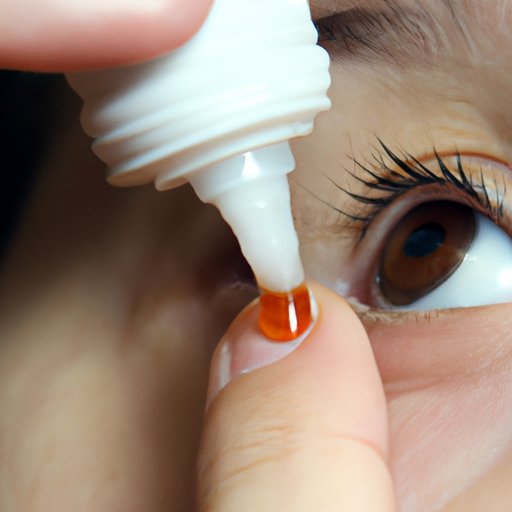I. Introduction
Red eyes are a common issue that can be caused by a variety of factors, such as lack of sleep, allergies, or eye strain. Not only can red eyes be uncomfortable and unsightly, but they can also be a sign of an underlying medical condition. Therefore, finding a solution for red eyes is crucial for both comfort and good eye health.
II. Home remedies for red eyes
One way to reduce redness and soothe eyes is through the use of natural home remedies. Cucumber slices, for instance, are a well-known remedy for puffy eyes due to their cooling and hydrating properties. Similarly, cold compresses can help constrict blood vessels and reduce inflammation. Another option is chamomile tea bags, which are known for their anti-inflammatory and antibacterial properties.
To use cucumber slices, simply place them on closed eyes for 10-15 minutes. For cold compresses, wrap a few ice cubes in a clean cloth and place it over closed eyes for 5-10 minutes. To use chamomile tea bags, steep them in hot water for a few minutes, then let them cool and place them over closed eyes for 10-15 minutes. It’s important to note that while these remedies are generally safe, people with allergies or sensitive skin should avoid using them. Additionally, using anything too cold or hot directly on the eyes can be damaging and may cause further irritation.
III. Eye drops for red eyes
If home remedies don’t provide enough relief, over-the-counter eye drops can also help reduce redness. Lubricating drops, or artificial tears, are a common option for people with dry eyes, as they help to add moisture to the eyes. Vasoconstrictor drops, on the other hand, work by shrinking blood vessels in the eye, which can help reduce redness, but should only be used for short periods of time as they can cause rebound redness and other side effects. Finally, allergy drops can help people with allergies by reducing inflammation and itchiness.
It’s important to choose the right type of eye drop based on your symptoms and avoid using them too frequently as this may lead to further eye irritation. Consult with an optometrist or ophthalmologist if you’re unsure which type of eye drop to use. Additionally, it’s crucial to follow the instructions on the packaging, and never share eye drops with others to prevent the spread of infection.
IV. Lifestyle changes to prevent red eyes
In addition to home remedies and eye drops, certain lifestyle changes can help prevent red, puffy eyes. Getting enough sleep, for instance, is crucial for good eye health as it allows the eyes to rest and prevent eye strain. Reducing screen time, especially before bedtime, can also help prevent eye strain and dryness. Additionally, staying hydrated can help keep the eyes moist and reduce dryness.
To incorporate these changes into your routine, try setting a regular sleep schedule, taking frequent breaks from screens, and keeping a water bottle nearby to remind you to drink water regularly. Doing so can not only help improve eye health, but overall health and well-being as well.
V. Medical treatments for red eyes
If home remedies, eye drops, and lifestyle changes don’t provide enough relief, it may be necessary to seek medical attention. Prescription eye drops, for example, can provide more targeted relief for specific eye conditions, such as glaucoma or uveitis. Steroid eye drops can also help reduce inflammation, but should only be used under medical supervision due to potential side effects such as cataracts and optic nerve damage. In some cases, surgery may be necessary to correct underlying eye issues.
It’s crucial to consult with an eye care professional if your red eyes persist or are accompanied by symptoms such as pain or vision changes. They can help determine the underlying cause of your red eyes and provide appropriate treatment options.
VI. Prevention tips for red eyes
While treating red eyes is important, preventing them in the first place can also be beneficial. Avoiding allergens, such as pollen or pet dander, can help prevent allergic reactions that may cause redness and discomfort. Wearing protective eyewear during activities such as sports or DIY projects can also help prevent eye injuries that may lead to red eyes.
Additionally, practicing good eye hygiene, such as washing your hands before touching your eyes and avoiding rubbing your eyes, can help reduce the risk of eye infections that may cause redness. By incorporating these prevention tips into your daily routine, you can help reduce your risk of developing red eyes.
VII. Conclusion
Red eyes can be uncomfortable and unsightly, but there are many solutions available to help reduce redness and provide relief. Home remedies, eye drops, lifestyle changes, and medical treatments are all options that can be effective in treating red eyes. It’s important to try different methods until you find what works best for you and to consult with an eye care professional if your symptoms persist. By taking care of your eyes, you can not only improve your eye health, but also your overall well-being.
